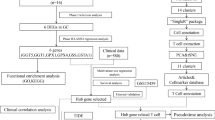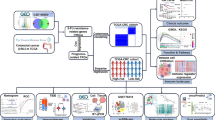Abstract
Imatinib Mesylate is the drug used for targeted tyrosine kinase inhibition in the beginning of management of all Chronic Myeloid Leukemia (CML) newly diagnosed cases. However, resistance presents a considerable limit to its efficacy. Currently, it is impossible to anticipate IM resistance which makes the recognition of early flags an important treatment goal in CML. In this work we studied the connection between microRNA 30a (miR-30a) and Beclin 1 mediated autophagy and IM resistance in Egyptian CML patients. The study included newly diagnosed (group I, n = 20), imatinib responder (group II, n = 30), imatinib resistant (group III, n = 30) CML patients and a healthy demographically matched control group (group IV, n = 20). miR-30a expression was assayed by quantitative reverse transcription polymerase chain reaction. The variation in expression of miR-30a between CML cases and healthy controls was calculated using relative quantification method (2−ΔΔCT). Beclin 1 was assayed in Peripheral blood mononuclear cells by western blotting. miR-30a was over expressed and Beclin 1 was under expressed in imatinib responders compared to resistant cases median 1.21(0.55–3.02) versus median 0.65 (0.03–1.0) (p = 0.001) and median 950.0 (400.0–2410.0) versus, median 1570.0 (920.0–5430.0) (p < 0.001) respectively. Beclin 1 correlated significantly positively with miR-30a in new cases (p = 0.001) and negatively in imatinib responders (p = 0.021). Receiver Operating Curves demonstrated the performances of miR-30a and Beclin 1 to detect imatinib resistance. They showed sensitivities of 97.14% and 94.29% and specificities of 53.33% and 42.22% at the cut-off values of 1 and 940 respectively. Both miR-30a and Beclin 1 levels showed a relation with imatinib response and can therefore be put forward as valuable markers for detection of resistance and may also have promising future therapeutic implications.












Similar content being viewed by others
References
Faderl STM, Estrov Z, O’Brien S, Kurzrock R, Kantarjian HM (1999) The biology of chronic myeloid leukemia. N Engl J Med 341:164–172
Siegel RL, Miller KD, Jemal A (2017) Cancer statistics. CA Cancer J Clin 67(1):7–30
Nowell PC (2007) Discovery of the Philadelphia chromosome: a personal perspective. J Clin Investig 117(8):2033–2035
DeAngelo DJ, Ritz J (2004) Imatinib therapy for patients with chronic myelogenous leukemia: are patients living longer? Clin Cancer Res 10(1):1–3
Apperley JF (2007) Part I: mechanisms of resistance to imatinib in chronic myeloid leukaemia. Lancet Oncol 8(11):1018–1029
Shintani T, Klionsky DJ (2004) Autophagy in health and disease: a double-edged sword. Science 306(5698):990–995
Hamilton A (2010) Investigation into the relevance of BCR-ABL for the survival of cancer stem cells in chronic myeloid leukaemia. University of Glasgow
Yu Y, Yang L, Zhao M, Zhu S, Kang R, Vernon P et al (2012) Targeting microRNA-30a-mediated autophagy enhances imatinib activity against human chronic myeloid leukemia cells. Leukemia 26(8):1752
Radich JP, Deininger M, Abboud CN, Altman JK, Berman E, Bhatia R et al (2018) Chronic myeloid leukemia, version 1.2019, NCCN clinical practice guidelines in oncology. J Natl Compr Cancer Netw 16(9):1108–1135
Beillard E, Pallisgaard N, Van der Velden V, Bi W, Dee R, van der Schoot E et al (2003) Evaluation of candidate control genes for diagnosis and residual disease detection in leukemic patients using ‘real-time’ quantitative reverse-transcriptase polymerase chain reaction (RQ-PCR): a Europe against cancer program. Leukemia 17(12):2474
Livak KJ, Schmittgen TD (2001) Analysis of relative gene expression data using real-time quantitative PCR and the 2 − ΔΔCT method. Methods 25(4):402–408
Waterborg JH (2009) The Lowry method for protein quantitation. Springer, The protein protocols handbook, pp 7–10
Gozuacik D, Akkoc Y, Ozturk DG, Kocak M (2017) Autophagy-regulating microRNAs and cancer. Front Oncol 7:65
San José-Enériz E, Román-Gómez J, Jiménez-Velasco A, Garate L, Martin V, Cordeu L et al (2009) MicroRNA expression profiling in imatinib-resistant chronic myeloid leukemia patients without clinically significant ABL1-mutations. Mol Cancer 8(1):69
Yang X, Chen Y, Chen L (2017) The versatile role of microRNA-30a in human cancer. Cell Physiol Biochem 41(4):1616–1632
Zou Z, Wu L, Ding H, Wang Y, Zhang Y, Chen X et al (2012) MicroRNA-30a sensitizes tumor cells to cis-platinum via suppressing beclin 1-mediated autophagy. J Biol Chem 287(6):4148–4156
Carew JS, Nawrocki ST, Giles FJ, Cleveland JL (2008) Targeting autophagy: a novel anticancer strategy with therapeutic implications for imatinib resistance. Biol Targets Therapy 2(2):201
Funding
No funding was received by the authors for conducting this study.
Author information
Authors and Affiliations
Corresponding author
Ethics declarations
Conflict of interest
The authors declare they have potential conflicts of interest, neither financial nor non-financial.
Human and Animal Rights
The study was conducted using human blood samples and an approval by the Ethics Review Board of the Alexandria University, Faculty of Medicine was obtained.
Informed Consent
Subjects’ informed consent was obtained upon sample withdrawal.
Additional information
Publisher's Note
Springer Nature remains neutral with regard to jurisdictional claims in published maps and institutional affiliations.
Electronic supplementary material
Below is the link to the electronic supplementary material.
Rights and permissions
About this article
Cite this article
Khalil, N.A., Desouky, M.N., Diab, I.H. et al. MicroRNA 30a Mediated Autophagy and Imatinib Response in Egyptian Chronic Myeloid Leukemia Patients. Indian J Hematol Blood Transfus 36, 491–497 (2020). https://doi.org/10.1007/s12288-019-01241-3
Received:
Accepted:
Published:
Issue Date:
DOI: https://doi.org/10.1007/s12288-019-01241-3




